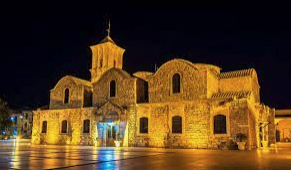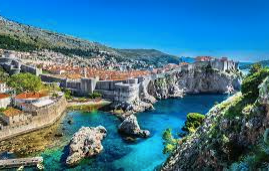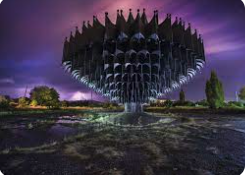Description
Byzantine Church of St Lazarus
The Byzantine Church of Saint Lazarus stands as a captivating landmark in Larnaca, Cyprus, renowned for its architectural grandeur and historical significance. Built in the late 9th century, this impressive structure is a testament to the island’s rich Byzantine heritage.
The church’s exterior exudes an aura of timeless elegance, adorned with intricate stonework and a distinctive dome. Its interior, equally captivating, features a spacious nave adorned with vibrant mosaics depicting scenes from the life of Saint Lazarus. The church also houses the saint’s tomb, located in a crypt beneath the altar.
The Byzantine Church of Saint Lazarus is deeply revered by the local community and attracts visitors from around the world. Its serene ambiance and rich history make it a place of immense spirituality and cultural significance.
The church’s construction is attributed to Byzantine Emperor Leo VI, who commissioned its building in the late 9th century. The church’s original structure underwent significant renovations in the 17th century, incorporating elements of Gothic and Baroque architecture. These alterations blended seamlessly with the original Byzantine style, creating a harmonious blend of architectural styles.
The church’s primary focus is the veneration of Saint Lazarus, a figure revered in Christianity for his remarkable resurrection by Jesus Christ. According to the Gospel of John, Jesus raised Lazarus from the dead after four days of burial. Lazarus continued to preach and teach, eventually becoming the bishop of Cyprus.
The church’s interior is adorned with captivating mosaics depicting scenes from the life of Saint Lazarus. These vibrant depictions, dating back to the 11th century, showcase the artistry and craftsmanship of Byzantine mosaicists. The mosaics illuminate the church’s walls and ceiling, adding a touch of celestial beauty to the sacred space.
The church’s most revered relic is the tomb of Saint Lazarus, situated in a crypt beneath the altar. The tomb is an object of deep reverence for the local community and attracts pilgrims from around the world. Visitors often pay their respects to the saint and offer prayers for his intercession.
The Byzantine Church of Saint Lazarus stands as a poignant reminder of the island’s rich cultural heritage and the enduring legacy of Saint Lazarus, a figure revered for his faith and connection to miracles. Its architectural beauty, historical significance, and spiritual aura make it a must-visit destination for anyone seeking to immerse themselves in the cultural tapestry of Larnaca and Cyprus.
Finikoudes Beach
Finikoudes Beach, fondly referred to as the “Golden Mile,” is a picturesque stretch of golden sand along the Mediterranean coast of Larnaca, Cyprus. Renowned for its tranquil waters, palm-lined promenade, and vibrant atmosphere, Finikoudes Beach is a popular destination for locals and tourists alike.
Spanning approximately 600 meters, Finikoudes Beach offers a welcoming environment for sunbathing, swimming, and water sports. The gentle waves, coupled with the shallow waters, make it an ideal spot for families with children.
The beach’s allure extends beyond its natural beauty. The picturesque promenade, lined with palm trees, restaurants, cafes, and shops, adds a touch of charm and excitement. Visitors can stroll along the walkway, savoring delicious food, indulging in refreshing drinks, or indulging in retail therapy.
Finikoudes Beach is also home to the Larnaca Marina, a bustling harbor that hosts a variety of activities, from yachting and boat trips to water sports and entertainment venues. The marina’s vibrant atmosphere adds to the overall allure of Finikoudes Beach.
With its pristine surroundings, tranquil atmosphere, and vibrant ambiance, Finikoudes Beach stands as a crown jewel of Larnaca’s coastal gems. It’s a place where visitors can unwind, soak in the sun’s warmth, and immerse themselves in the laid-back Mediterranean lifestyle.
Larnaca Salt Lake and Hala Sultan Tekke
Larnaca Salt Lake, a vast expanse of shimmering water nestled on the coast of Larnaca, Cyprus, is a captivating natural wonder that transforms dramatically throughout the year. During the summer months, the lake dries out, revealing a vast expanse of salt crystals and a mesmerizing landscape of cracked earth.
As the winter rains arrive, the lake fills with water, attracting a remarkable array of flamingos, who flock to the lake’s shallow waters in search of food. These graceful birds, with their vibrant pink plumage, add a touch of spectacle to the lake’s serene beauty.
Amidst the lake’s ever-changing scenery, Hala Sultan Tekke, a revered Muslim shrine, stands as a testament to faith and tradition. The complex, nestled on the lake’s western shore, was built in the 18th century to honor Umm Haram, a companion of the Prophet Muhammad, who is believed to have met her demise here.
The mosque, adorned with intricate carvings and Islamic calligraphy, is a place of quiet contemplation and pilgrimage. Visitors can wander through the serene courtyard, admire the mosque’s architectural beauty, and immerse themselves in the tranquil atmosphere of this sacred site.
The Larnaca Salt Lake and Hala Sultan Tekke offer a unique blend of natural beauty, cultural significance, and spiritual serenity. Visitors can experience the changing moods of the lake, witness the majestic spectacle of flamingos, and explore the tranquil grounds of the shrine, making it a truly memorable destination for anyone seeking a glimpse into Cyprus’s diverse and captivating landscape.
Kamares Roman Aqueduct
The Kamares Aqueduct, also known as the Bekir Pasha Aqueduct, is a magnificent architectural structure located near Larnaca, Cyprus. Standing proudly amidst the Cypriot countryside, this impressive aqueduct stands as a testament to the island’s rich history and ingenious engineering.
Built in 1747 during the Ottoman era, the Kamares Aqueduct was commissioned by Ebubekir Pasha, the then-governor of Larnaca. The structure, spanning approximately 1.6 kilometers, was designed to transport water from the Troödos Mountains to the city of Larnaca.
The aqueduct’s construction involved a series of 75 arched spans, each meticulously crafted from locally sourced limestone. The arches, gracefully spanning the valley, create a visually striking and architecturally significant landmark.
The Kamares Aqueduct’s unique design and construction have earned it a place among Cyprus’s most iconic landmarks. The aqueduct’s graceful arches, harmonious proportions, and enduring presence make it a captivating symbol of the island’s rich architectural heritage.
Beyond its architectural beauty, the Kamares Aqueduct holds historical significance. It served as a vital source of water for Larnaca for over two centuries, until it was decommissioned in 1939. Today, the aqueduct stands as a reminder of the ingenuity and resourcefulness of the past, showcasing the island’s ability to harness its natural resources for the benefit of its inhabitants.
The Kamares Aqueduct is a must-visit destination for anyone seeking to explore Cyprus’s rich history and architecture. Its imposing presence, intricate arches, and historical significance make it a truly remarkable monument that has stood the test of time.
Larnaka Mediaeval Castle
Nestled amidst the bustling coastal town of Larnaca, Cyprus, the Medieval Castle stands as a captivating vestige of the island’s rich history. Dating back to the Middle Ages, this imposing fortress has witnessed centuries of change, serving as a sentinel of protection, a hub of trade, and a repository of cultural heritage.
The castle’s origins remain shrouded in mystery, with some suggesting it was constructed during the Frankish era, while others believe it dates back to the Lusignan dynasty. Regardless of its exact beginnings, the castle underwent significant renovations during the Ottoman period, taking its current form.
Today, the Medieval Castle stands as a testament to the island’s diverse cultural tapestry. Its imposing walls, adorned with intricate stonework, exude an air of timelessness, while its interior houses a small museum that showcases artifacts from various eras. Visitors can wander through the castle’s chambers, imagining the lives of those who once called it home.
The Medieval Castle’s significance extends beyond its historical value. It serves as a picturesque landmark, a favored backdrop for photographs and a symbol of Larnaca’s enduring heritage. Its presence adds a touch of charm and intrigue to the city’s vibrant atmosphere.
Whether you’re an avid history buff, an art enthusiast, or simply seeking a glimpse into Cyprus’s past, the Medieval Castle is a must-visit destination. Its intriguing history, captivating architecture, and serene ambiance make it a truly unforgettable landmark.
Kebir / Buyuk Cami Mosque
The Kebir-Buyuk (Great) Mosque, also known as the Cami Kebir or Buyuk Cami, is a notable landmark in Larnaca, Cyprus. It stands proudly as a testament to the city’s rich history and cultural diversity, showcasing the harmonious intermingling of Cypriot traditions.
Built in the 12th or 13th century, the Kebir-Buyuk Mosque underwent significant transformations over the years, reflecting the changing political and cultural landscape of Cyprus. Originally a Catholic church dedicated to Saint Catherine, the mosque was converted into an Islamic place of worship during the Ottoman era.
The mosque’s architectural style embodies a blend of Byzantine, Ottoman, and Venetian influences, reflecting the island’s intricate cultural heritage. Its whitewashed walls, adorned with intricate arches and intricate carvings, radiate an aura of serene beauty.
The interior of the mosque is equally captivating, with a spacious central courtyard surrounded by a covered prayer hall. The hall’s walls are adorned with intricate geometric patterns and Arabic calligraphy, creating a mesmerizing tapestry of Islamic art and design.
Towering above the mosque is a majestic minaret, a symbol of the mosque’s spiritual significance. The minaret, made of white limestone, gracefully pierces the sky, beckoning worshippers to gather for prayer.
Adjacent to the mosque lies a serene graveyard, where the remains of revered Muslim figures lie in tranquility. The graveyard’s tombstones, adorned with Arabic inscriptions, add a touch of historical depth to the mosque’s surroundings.
The Kebir-Buyuk Mosque stands as a beacon of cultural diversity and religious harmony in Larnaca, Cyprus. Its architectural beauty, historical significance, and serene ambiance make it a must-visit destination for anyone seeking to immerse themselves in the city’s rich tapestry of traditions.
Skala – The Turkish Quarter
Skala, formerly known as Iskele, is a picturesque neighbourhood in Larnaca, Cyprus, that was once home to a significant Turkish Cypriot population. Today, it remains a charming and atmospheric quarter, with narrow cobblestone streets lined with traditional whitewashed houses adorned with colorful shutters and flowerpots.
The area’s rich history is evident in its architecture and cultural heritage. Many of the buildings date back to the Ottoman period, and there are several mosques and Turkish Cypriot shops and restaurants in the district.
In recent years, Skala has undergone a revival, with a number of new art galleries, cafes, and bars opening up. The area is now a popular destination for both tourists and locals alike, who come to appreciate its unique atmosphere and vibrant cultural scene.
Skala is also a great place to experience traditional Cypriot cuisine. There are several excellent restaurants serving up delicious meze, kebabs, and other Cypriot specialties.
If you’re looking for a taste of Larnaca’s Turkish Cypriot heritage, then be sure to visit Skala. It’s a charming and authentic neighborhood that will transport you back in time.
Ancient Kition
Nestled amidst the modern city of Larnaca, Cyprus, the archaeological site of Ancient Kition stands as a testament to the island’s rich and diverse past. This ancient city, once a bustling hub of commerce and culture, flourished from the Bronze Age to the Late Roman period, leaving behind a treasure trove of archaeological remains that offer fascinating insights into its inhabitants’ lives and customs.
The ruins of Ancient Kition are spread over a wide area, revealing the city’s impressive fortifications, temples, and tombs. Visitors can wander through the excavated streets, imagining the bustling marketplaces and lively social gatherings that once took place here.
One of the most notable features of Ancient Kition is the Temple of Astarte, a sanctuary dedicated to the Phoenician goddess of love and fertility. The temple’s ruins, including a large courtyard, a sacrificial altar, and a series of columns, provide a glimpse into the city’s religious practices.
Another highlight is the Hypogeum of the Pillared Hall, an underground tomb complex dating back to the 7th century BC. This impressive structure, with its intricate carvings and chambers, offers a fascinating glimpse into the burial practices of Ancient Kition’s elite.
The archaeological site of Ancient Kition is a treasure trove of Cyprus’s past, offering a unique opportunity to step back in time and explore the city’s rich history and culture. Visitors can wander through the ruins, marvel at the architectural wonders, and imagine the lives of those who once called this ancient city home.
The Doors of Larnaca
The Doors of Larnaca are a set of colorful, hand-painted doors found throughout the city of Larnaca in Cyprus. They were created in the 1980s by a group of local artists as a way to revitalize the city’s historic center and promote tourism.
The doors are painted in a variety of bright colors and designs, often with traditional Cypriot motifs. They are found on both residential and commercial buildings, and they add a touch of vibrancy to the city’s streets.
The Doors of Larnaca have become a popular tourist attraction, and they are often photographed by visitors. They are also a source of pride for the local community, and they have helped to make Larnaca a more colorful and welcoming city.
In addition to their aesthetic appeal, the Doors of Larnaca also serve a practical purpose. They help to protect the city’s historic buildings from the elements and from vandalism. They also provide a sense of identity and character to the different neighborhoods of Larnaca.
The Doors of Larnaca are a unique and charming feature of Larnaca, and they are a testament to the city’s creativity and cultural heritage. They are a must-see for any visitor to Larnaca, and they are sure to bring a smile to your face.
Kyriazis Medical Museum
Nestled in the heart of Larnaca, Cyprus, the Kyriazis Medical Museum stands as a testament to the island’s rich medical heritage. Established in 2011, this unique museum houses an intriguing collection of medical artifacts, books, and documents that trace the evolution of healthcare in Cyprus from ancient times to the 20th century.
Stepping into the museum is like embarking on a journey through time, where visitors can marvel at the tools and techniques employed by Cypriot physicians across the ages. Be it the elaborately decorated surgical instruments of the Ottoman era or the rudimentary medical equipment used in Cyprus’s early days, each piece holds a story that speaks volumes about the progress of medicine.
The museum’s collection is not limited to tangible objects; it also includes a trove of written records, including medical treatises, prescriptions, and even patient records. These documents provide valuable insights into the understanding and treatment of diseases throughout Cyprus’s history.
Beyond its historical significance, the Kyriazis Medical Museum offers a unique educational experience. Visitors can interact with the exhibits, handling some of the artifacts and exploring the written records, gaining a firsthand understanding of the medical practices that have shaped Cyprus’s healthcare landscape.
Whether you’re an avid history buff, a medical enthusiast, or simply curious about the evolution of healthcare, the Kyriazis Medical Museum is a must-visit destination for anyone seeking to delve into Cyprus’s rich medical heritage.




Reviews
There are no reviews yet.